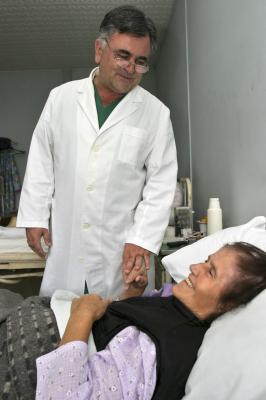
October 4, 2017 — Findings from a new multicenter, international clinical trial confirm the effectiveness of high-dose brachytherapy or internal radiation therapy, for managing locally advanced cervical cancer. Tumor control was significantly better following four fractions of 7 Gray (Gy) each than following two, 9-Gy fractions of high-dose-rate (HDR) brachytherapy, but neither overall survival nor severe treatment-related side effects differed between the treatment groups.
Findings from the International Atomic Energy Agency (IAEA) trial were presented at the 59th Annual Meeting of the American Society for Radiation Oncology (ASTRO), Sept. 24-27 in San Diego.
“Cervical cancer is a leading cause of cancer death among women in the developing world, and 80 percent of these patients live in lower- or middle-income countries, such as the ones in our trial. It is essential that we have data applicable to these real-world settings,” said May Abdel-Wahab, M.D., Ph.D., FASTRO, a study co-author and director of the Division of Human Health at the International Atomic Energy Agency in Vienna, Austria.
“Our trial demonstrates that combining pelvic radiation therapy with four fractions of 7 Gy HDR brachytherapy is effective for locally advanced cervical cancer. In addition, it gives physicians data-supported guidance from a large, randomized study on what to expect in terms of outcomes if a regimen of two, 9-Gy fractions is used in resource-constrained settings.”
The prospective, randomized multicenter trial tested two approaches to delivering HDR brachytherapy with or without chemotherapy for patients with intermediate-stage cervical cancer. All patients were to receive 46 Gy of curative-intent pelvic external beam radiation therapy in 23 fractions. All patients also were to receive HDR brachytherapy in one of two dosing schedules. Half of the patients were randomized to receive four applications of 7 Gy each (4x7 Gy), while the other half were randomized to receive two applications of 9 Gy each (2x9 Gy). Additionally, half of the patients in each brachytherapy group were randomized to receive chemotherapy (cisplatin 40 mg/m2 in weeks 1-5), while the other half did not receive chemotherapy. The median follow-up for surviving patients was 48 months (range 1-84 months).
A total of 601 patients with intermediate-stage cervical cancer were enrolled between September 2005 and May 2010. Patients in this international trial represented seven countries, including Mumbai (257 cases), Peru (147), South Africa (76), Brazil (53), Pakistan (31), Morocco (19) and Macedonia (18). The average patient age was 49 years (range 26-71). All patients had either stage IIB (73.2 percent) or stage IIIB (26.8 percent) disease, and no patients had contraindications for radiation therapy or chemotherapy.
Overall survival at five years following treatment was 67.2 percent for all patients (95 percent CI = 62.7- 71.2 percent). The survival rate was higher for women with stage IIB disease (71 percent) than for stage IIIB disease (58 percent) (p = 0.03). Overall survival rates for patients who received pelvic radiation and 4x7 Gy HDR brachytherapy were 73.1 and 62.2 percent with and without chemotherapy, respectively. Among patients in the 2x9 Gy HDR brachytherapy group, rates were 65.1 and 68.3 percent with and without chemotherapy, respectively (p = 0.1 between the four arms).
Among patients with stage IIB disease, neither brachytherapy dosing nor the addition of chemotherapy had a significant influence on the overall survival rate. Survival rates were estimated using the Kaplan-Meier method and compared between arms using the log-rank test.
Five-year rates of locoregional control, or tumor control in the site and surrounding area of the primary tumor, favored the 4x7 Gy brachytherapy approach, with or without the addition of systemic therapy (p = 0.0007). Rates for patients who received pelvic radiation and 4x7 Gy brachytherapy were 88 and 89 percent with and without chemotherapy, respectively, compared to control rates on the 2x9 Gy brachytherapy arm of 78 and 75 percent with and without chemotherapy, respectively.
Severe treatment-related side effects did not differ significantly between treatment arms. Actuarial rates of grade 3 or higher genitourinary side effects for patients who received pelvic radiation and 4x7 Gy brachytherapy were 5.9 and 7.3 percent with and without chemotherapy, respectively; for the 2x9 Gy brachytherapy arm, they were 7.2 and 7.3 percent with and without chemotherapy, respectively. Actuarial rates of grade 3 or higher gastrointestinal side effects for patients who received pelvic radiation and 4x7 Gy brachytherapy were 6 and 5.3 percent with and without chemotherapy, respectively; for the 2x9 Gy brachytherapy arm, rates were 5.9 and 5.3 percent with and without chemotherapy, respectively.
There was a modest positive effect of cisplatin on toxicity in the 2x9 Gy brachytherapy arm only (p = 0.066), but chemotherapy did not significantly influence overall survival, cancer-specific survival or tumor control in the cervix and surrounding region.
“The findings that chemotherapy did not significantly affect survival or tumor control in this setting seem to be different than the results of the meta-analysis from the Chemoradiotherapy for Cervical Cancer Meta-Analysis Collaboration, which found six percent differences in local control due to the effect of chemotherapy,” explained Abdel-Wahab. “However, it is important to note that our study was not powered to detect differences in local control that are less than 10 percent. In other words, the results of the two studies are not mutually exclusive.”
In addition to providing guidance for clinical teams treating women with cervical cancer, the study also demonstrates the feasibility of conducting global clinical trials, including trials in lower- and middle- income countries where resources for research tend to be more restricted.
For more information: www.astro.org


 December 11, 2025
December 11, 2025 








